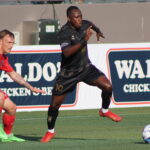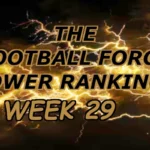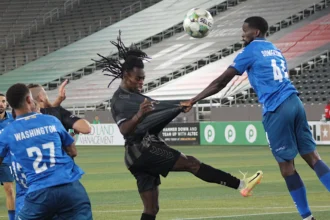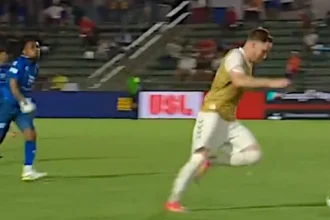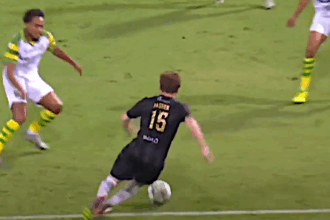With the two losses this week, the Legion is now in an 8-game winless streak (including a Jäger Cup loss). That’s the worst since a 12-game streak all the way back in the 2019 inaugural season (including an Open Cup loss). Even with that streak the Three Sparks still managed to make the post-season with a 12-15-7 record. The team is currently 4-11-10 and looking like it will not make the playoffs for the second straight year.
In addition to that, the team has given up points in 9 games in which it held a lead at some point, losing 4 and drawing 5. That’s 22 points wasted, which happens to be the team’s points total so far this season. Against Orange County the team even managed to squander 4 separate leads.
This is arguably the worst season the club has ever had. The team got off to a rocky start and head coach Tommy Soehn was axed with a league record of 0-2-2 and an embarrassing loss to League Two’s Little Rock Rangers in the Open Cup. Eric Avila led the team to 1-1-0 in league play and a win in the Jäger Cup. Mark Briggs came in with a team that looked like it was about to turn around but has only been able to produce a league record of 3-8-8 and a quarterfinal appearance in the Jäger Cup. The 3 wins were over The Miami FC, Sacramento Republic and North Carolina FC.
It gets worse: the Legion has never had a season with points per game of less than 1.26. Again, that was back in 2019. Currently the team is at 0.88 PPG and would max out at 1.23 if it wins all 5 remaining games. The team is also scoring at its lowest rate since 2019 (1.24 GPG) and conceding at its highest rate ever (1.76 GPG).
It’s blatantly obvious that something is just not right. Normally, this would be the kind of evaluation to make at the end of a season but now seems as good as that already. So, here we go with a rant.
Overall, it’s probably a combination of factors. First off is that new coach bump that clearly never came about. Most analysis indicates that such bumps primarily occur as a result of players wanting to impress the new man in charge. From the get-go Briggs was unequivocal about expecting full commitment and that anything less would not be tolerated. It doesn’t take a rocket scientist to see that the players have not given him that. There have been quite a few roster changes and some of the newcomers have performed better than the existing squad. Sebastian Tregarthen, Amir Daley, Sam Shashoua, Jackson Travis and most recently Peter-Lee Vassell have all stepped up. Sebastian Saucedo looked like he would provide some additional scoring power but was only able to make 3 appearances for 44 minutes before his lack of playing time caught up with him. Maliek Howell has made just 2 appearances and has been hurt. Sam Shashoua has been a real ray of sunshine but he’s also suffering right now.
Saucedo, by the way, does expect to be back to finish out the season but is probably at least a week away still. He also had some interesting comments after the Tampa Bay Rowdies loss last Wednesday. He noted that it’s a standard reaction to blame the coach for an underperforming team but that ultimately it’s the players on the field who have to take responsibility. That’s particularly true in a sport like soccer where the coach has relatively limited input once the team takes the field. Football and baseball coaches have an ongoing impact on play and as a result bear a larger share of the blame.
It’s not just the new guys who have had injuries either. Tyler Pasher and A.J. Paterson both started the season recuperating from surgeries and several other players have gone down over the course of the season. Pasher himself is only just back from his second absence and Dawson McCartney seems to be a favorite target for some of the league’s enforcers. Moses Mensah went down for the year. Those are just the most obvious ones. Part of the injury problem the team has faced is the same lack of commitment in practice as in games. Players working hard on a day-to-day basis don’t get hurt as much. Several of the injuries have even occurred in practice.
Another—and currently unsolvable—problem is the team’s home field. Protective Stadium is technically the largest home venue in the USL Championship by far with a capacity of 47,100. The next largest is Miami’s Pitbull Stadium, at just 20,000. The Oakland Coliseum is physically larger; its 63,000 maximum seating capacity gets reduced to 15,000 for the Roots (and to 12,000 for co-tenant Major League Cricket). Miami has plans for a 15,000-seat stadium in Homestead. That would push Louisville’s Lynn Family Stadium into second place with 15,304.
That would make Protective the largest in the league by a multiple of over 3. With attendances well under 5,000 it’s an empty cavern. With the exception of the north end the seats are also well back from the field. The Coliseum of course has similar issues. And then there are the stadium-sharing arrangements to make things worse, not to mention the incompetent management of the BJCC. No surprise then that the Legion has won just 2 league games at home all year (against El Paso Locomotive under Avila and against Sacramento under Briggs). 12 of the team’s 22 points have been earned on the road (and on one less game). Protective is not a fortress. Oakland similarly has more wins and points away and Miami’s home record is barely better than their away record. None of the three locations are conducive to great atmospheres to provide the team with home support. The playing surface is also an issue. Unfortunately there are no real alternative options right now.
As it stands there are only 3 areas where the Legion can rapidly improve: playing roster, coaching and front office. By rapidly I mean for the 2026 season. Which that this offseason will have to produce some serious shakeups.
The front office has more to do with the on-field product than some might realize since it is deeply involved in all hiring decisions. I acknowledge that the team has a knack of locating solid talent, although it has had its share of busts, and the strengthening of the analytics staff this year has resulted in some good pickups over the course of the season. That being said, I have never really been sold on Jay Heaps. I first became aware of him in September 2017 when the Heaps-coached New England Revolution got blasted 0-7 by then-newcomers Atlanta United. That was his last game in charge; he was replaced on an interim basis by…Tommy Soehn. Within a year both had been hired by the Legion.
It took Heaps at least a year longer than it should have to fire his old friend Tommy. The hiring of Mark Briggs was done in fairly short order (meaning it was likely already in the works when Soehn was released). But was it the right hire? Briggs has also so far failed to generate results. He did inherit a roster that probably does not fit his preferred playing style and he is far more emotional in his management style than Soehn. The team seems generally unwilling to fully implement his style and is prone to switching off at critical moments and making utterly avoidable mistakes. But that raises the question of whether he will be around next year. If he (and his agent) made the smart deal a guaranteed 2026 season should be in his contract. If not, who knows. Even if it is, will he want to be here next year? He has a brand to protect after all.
There will be a good number of attractive openings next year. The inevitable firings aside, the league will have a major expansion year with as many as 10 new teams across the Championship and League One. He may find those appealing. The 2026 status of Eric Avila ought also to be up in the air. He should by rights be a prime candidate for open head coaching positions in the USL; I would be very surprised if he does not get one of those open slots. This then remain a huge question mark.
Regardless of who is leading the team next year, that leaves the player roster. As noted above, several new players have been good additions. The problem is that a good few of them are on loan, such as Shashoua, Daley and Travis. Other loanees not mentioned include Taigo Suarez and Ronaldo Damus. The Legion has an option to acquire Damus on a full contract but that would also require him to agree to it. Which I tend to think he won’t.
Other players should not be invited back. As much as Enzo Martinez and Tyler Pasher have done for this team, they are both getting up there in age (34 and 31 respectively) and are not the players they once were. As noted above, Tyler has been hampered by ongoing injury issues and has definitely lost a step or two. Enzo just doesn’t seem to have that it factor any more. Matt van Oekel just turned 39 and really needs to hang his boots up. Phanuel Kavita is the only other player over 30 but I would say he is still at the top of his career. Younger players likely not to return (in my opinion): Ethan Kos, Edwin Laszo, Stephen Turnbull, Erik Centeno and Kameron Lacey. Most of them haven’t played much, if at all, or (in the case of Laszo) have been less than satisfactory.
The Three Sparks do have 2 players out on loan: Temi Ereku and Lucca Dourado, both at Forward Madison. Lucca in 17 games is Madison’s second-best scorer with 5 goals (1 every 200 minutes) and is looking every bit the threat he was in college. He should be coming back. Temi has barely played (just 144 minutes); he likely won’t.
That’s as many as 13 potentially open roster spots. Which means that whoever is coaching the team in 2026 could have the opportunity to build from the ground up. It would also create opportunities for players to step into starting positions in the USL Championship that they deserve but have not had the chance to get. However, the expansion teams will of course be challenging for the top players which means that the available talent pool will be stretched like never before. The Legion has historically been very good at finding players from unlikely sources, both domestically and internationally, so that may not be too much of a problem. That analytics staff should expect a lot of overtime.
To sum up, things have to change. Dramatically. We could—we should—be looking at Legion Mk. III in 2026.

